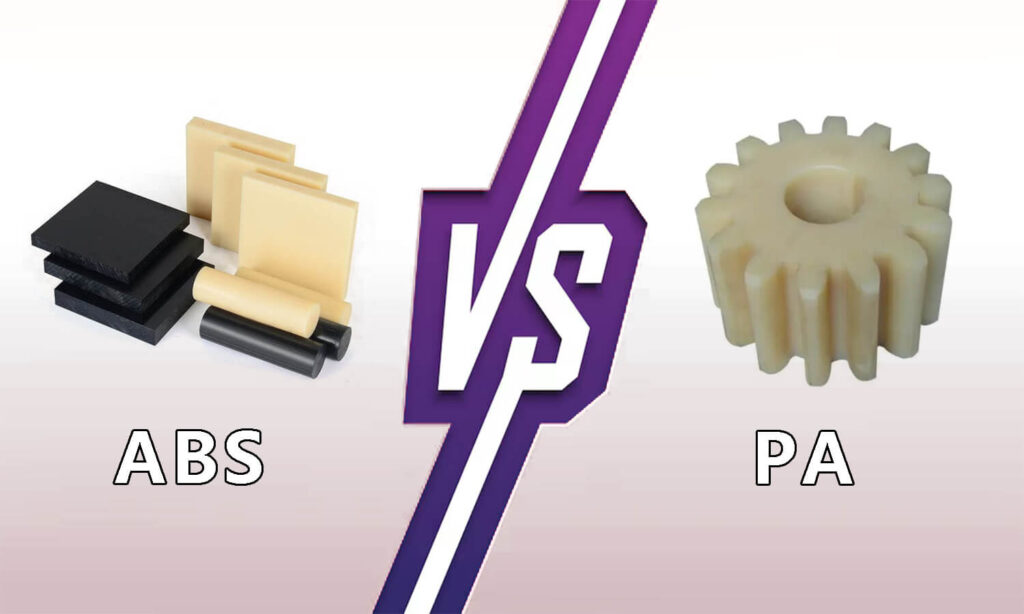Pendahuluan
Dalam lanskap industri saat ini, memilih bahan yang tepat dapat membuat perbedaan besar dalam kinerja produk, daya tahan, dan efektivitas biaya. ABS (Acrylonitrile Butadiene Styrene) dan PA (Poliamida, umumnya dikenal sebagai Nylon) adalah dua termoplastik populer yang banyak digunakan di berbagai industri, mulai dari otomotif hingga elektronik konsumen. Memahami perbedaan antara ABS dan PA sangat penting bagi produsen, insinyur, dan perancang produk yang berusaha menyeimbangkan fungsionalitas dengan kelayakan ekonomi. ABS vs PA, artikel ini mengeksplorasi perbedaan utama, properti, dan aplikasi ABS dan PA untuk membantu Anda membuat pilihan material yang tepat.

ABS - Fitur dan Aplikasi
Definisi dan Komposisi ABS
ABS adalah kopolimer yang dibuat dengan menggabungkan akrilonitril, butadiena, dan stirena, sehingga menghasilkan plastik tahan lama yang dikenal dengan kekokohan, ketahanan terhadap benturan, dan keefektifan biaya. Komposisi ini memungkinkan ABS dicetak dengan mudah, sehingga ideal untuk desain yang rumit dan bentuk yang mendetail.
Properti Utama ABS
ABS dihargai karena kekuatan mekanis, ketangguhan, dan ketahanannya terhadap goresan dan penyok. Bahan ini juga memiliki stabilitas dimensi yang baik dan dapat menahan panas sedang serta faktor lingkungan, meskipun tidak cocok untuk aplikasi panas tinggi.
Aplikasi Umum ABS
Industri Otomotif: ABS digunakan secara luas pada interior mobil, dasbor, dan komponen trim, di mana daya tahan dan kemudahan pembuatan menjadi prioritas.
Elektronik Konsumen: Casing untuk banyak perangkat elektronik, seperti laptop, ponsel, dan remote control, terbuat dari ABS karena sifatnya yang ringan dan tahan benturan.
Peralatan Rumah Tangga: Dari penyedot debu hingga rak kulkas, ABS adalah pilihan populer untuk komponen yang memerlukan kekakuan dan daya tahan dalam penggunaan yang sering.
PA - Fitur dan Aplikasi
Definisi dan Komposisi PA (Nilon)
Poliamida, umumnya disebut sebagai Nylon, adalah jenis polimer sintetis yang berasal dari minyak bumi. Poliamida dikenal karena struktur seratnya yang kuat, yang memberikan kekuatan tarik tinggi, fleksibilitas, dan ketahanan terhadap abrasi.
Properti Utama PA
Kekuatan dan ketahanan PA, serta ketahanan kimia dan keausannya yang sangat baik, membuatnya sangat cocok untuk aplikasi yang berat. Bahan ini dapat bertahan pada suhu tinggi dan sering digunakan di lingkungan yang membutuhkan kekuatan mekanis di bawah tekanan.
Aplikasi Umum PA
Aplikasi Teknik dan Industri: Karena daya tahan dan ketahanannya yang tinggi terhadap keausan, PA sering digunakan pada roda gigi, bantalan, dan suku cadang mesin.
Industri Tekstil: Nilon adalah bahan pokok dalam industri tekstil, ditemukan dalam pakaian, pelapis, dan pakaian olahraga karena fleksibilitas dan ketangguhannya.
Barang Konsumsi: Barang sehari-hari seperti bulu sikat gigi, tali pancing, dan bahan kemasan mendapat manfaat dari ketahanan dan keserbagunaan PA.
Perbandingan Rinci antara ABS dan PA
Sifat Mekanis
Kekuatan dan Kekakuan: PA umumnya memiliki kekuatan tarik dan fleksibilitas yang lebih tinggi daripada ABS, yang dapat membuatnya lebih cocok untuk komponen yang terpapar pada tekanan dan gerakan yang tinggi.
Resistensi Dampak: ABS dikenal dengan ketahanan benturannya yang superior, menjadikannya pilihan yang lebih baik untuk aplikasi yang membutuhkan penyerapan guncangan.
Resistensi Kimia
PA menunjukkan ketahanan yang lebih besar terhadap bahan kimia dan pelarut, terutama terhadap minyak dan lemak, sedangkan ABS lebih rentan terhadap degradasi di bawah paparan bahan kimia.
Sifat Termal
ABS dapat menahan suhu sedang, sehingga cocok untuk aplikasi serba guna, sementara stabilitas termal PA yang lebih tinggi memungkinkannya bekerja dengan baik di lingkungan yang sangat panas.
Perbandingan Biaya
ABS umumnya lebih hemat biaya daripada PA, menjadikannya bahan pilihan untuk aplikasi di mana kendala anggaran sangat signifikan dan sifat performa tinggi tidak diperlukan.
Memilih Bahan yang Tepat
Faktor yang Perlu Dipertimbangkan
Persyaratan Aplikasi Khusus: Penggunaan yang dimaksudkan memainkan peran penting. Untuk aplikasi dengan tekanan tinggi, kekuatan PA mungkin lebih sesuai, sementara ABS menawarkan keterjangkauan yang lebih besar untuk penggunaan berdampak rendah.
Pertimbangan Lingkungan: Pertimbangkan lingkungan tempat produk akan terpapar. PA lebih disukai dalam pengaturan yang penuh bahan kimia, sedangkan ABS ideal untuk aplikasi dengan eksposur rendah.
Proses Pengambilan Keputusan
Mengevaluasi persyaratan aplikasi, batasan anggaran, dan faktor lingkungan dapat memandu pemilihan bahan. Membuat prototipe dengan kedua bahan tersebut juga dapat bermanfaat untuk menilai kinerja dunia nyata.
Pertanyaan yang Sering Diajukan (FAQ)
A. Apa perbedaan utama antara ABS dan PA?
ABS dikenal dengan ketahanan benturan dan keterjangkauannya, sedangkan PA dihargai karena kekuatan tarik, ketahanan termal, dan daya tahan di bawah tekanan. Setiap bahan memiliki keunggulan berbeda yang cocok untuk aplikasi yang berbeda.
B. Bahan mana yang lebih baik untuk aplikasi otomotif?
ABS sering digunakan pada suku cadang otomotif interior karena kemampuannya untuk dibentuk dan hemat biaya, tetapi untuk suku cadang dengan tekanan tinggi seperti roda gigi dan bushing, PA mungkin merupakan pilihan yang lebih disukai karena kekuatannya.
C. Apakah ABS dan PA dapat didaur ulang?
Ya, baik ABS maupun PA dapat didaur ulang. ABS dapat dilebur dan dibentuk ulang, sedangkan PA memerlukan proses daur ulang khusus karena titik leleh dan ketangguhannya yang tinggi.
Kesimpulan dari ABS vs PA
ABS dan PA adalah termoplastik serbaguna dengan sifat yang berbeda yang membuatnya berharga dalam berbagai aplikasi. Sementara ABS menawarkan ketahanan benturan dan keterjangkauan harga, PA menonjol karena kekuatannya, ketahanan terhadap bahan kimia, dan toleransi terhadap suhu. Memilih bahan yang tepat tergantung pada persyaratan khusus, termasuk kebutuhan mekanis, faktor lingkungan, dan kendala anggaran. Dengan mempertimbangkan faktor-faktor ini secara cermat, bisnis dan produsen dapat mengoptimalkan kinerja produk, umur panjang, dan efisiensi biaya. Memilih bahan yang tepat dapat menghasilkan kepuasan produk yang lebih baik, daya tahan yang lebih baik, dan pada akhirnya, investasi yang lebih cerdas.
